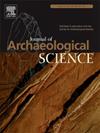The 12th century bronze doors of Bonanno di Pisa in Monreale and Pisa: Materials and manufacture
IF 2.6
1区 地球科学
Q1 ANTHROPOLOGY
引用次数: 0
Abstract
Bonanno di Pisa is, next to Barisano di Trani and Oderisius of Benevento, amongst the most renowned mediaeval Italian bronze casters. Bonanno is responsible for the biggest mediaeval metal door, the almost 8 m high main door of the Cathedral of Monreale, Sicily, built in 1185/1186, and the San Ranieri door of the Cathedral of Pisa, Tuscany, finished in 1180. He was also responsible for the Porta Reale (also Cathedral of Pisa; 1179/1180), which was destroyed in the 1595 fire. Contemporary doors made of bronze or brass are rare: from the 12th century, only about 17 doors are still preserved, nevertheless being part of the biggest complex of mediaeval monumental bronzes. In this paper, the chemical composition as well as manufacturing and assembling of the two preserved doors are discussed. Both the Pisa and Monreale doors were made of leaded tin bronze. In the case of Monreale, chemical analysis confirmed the art historical suspicion that the central leaf was not from Bonanno's workshop, as indicated by a different style and chemical composition. We also identified the types of wood used for the wooden elements of the doors, mainly silver fir (Monreale) and elm (Pisa).
Monreale和比萨Bonanno di Pisa的12世纪青铜门:材料和制造
比萨的博纳诺与特拉尼的巴里萨诺和贝内文托的奥德里修斯一样,是中世纪意大利最著名的青铜铸造者之一。Bonanno负责最大的中世纪金属门,西西里岛Monreale大教堂近8米高的正门,建于1185/1186年,以及托斯卡纳比萨大教堂的圣拉涅利门,完成于1180年。他还负责了皇家门(也称为比萨大教堂);1179/1180),在1595年的大火中被毁。由青铜或黄铜制成的当代门非常罕见:从12世纪开始,只有大约17扇门仍然保存下来,尽管如此,它们是中世纪青铜纪念物最大建筑群的一部分。本文讨论了两种保存门的化学成分、制作和组装方法。比萨门和蒙里尔门都是用含铅锡青铜制成的。在Monreale的案例中,化学分析证实了艺术史上的怀疑,即中央叶子不是来自Bonanno的工作室,这表明了不同的风格和化学成分。我们还确定了用于门的木制元素的木材类型,主要是银杉(Monreale)和榆树(Pisa)。
本文章由计算机程序翻译,如有差异,请以英文原文为准。
求助全文
约1分钟内获得全文
求助全文
来源期刊

Journal of Archaeological Science
地学-地球科学综合
CiteScore
6.10
自引率
7.10%
发文量
112
审稿时长
49 days
期刊介绍:
The Journal of Archaeological Science is aimed at archaeologists and scientists with particular interests in advancing the development and application of scientific techniques and methodologies to all areas of archaeology. This established monthly journal publishes focus articles, original research papers and major review articles, of wide archaeological significance. The journal provides an international forum for archaeologists and scientists from widely different scientific backgrounds who share a common interest in developing and applying scientific methods to inform major debates through improving the quality and reliability of scientific information derived from archaeological research.
 求助内容:
求助内容: 应助结果提醒方式:
应助结果提醒方式:


